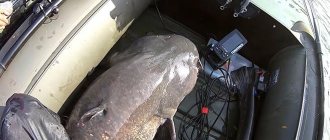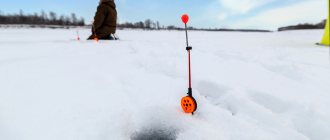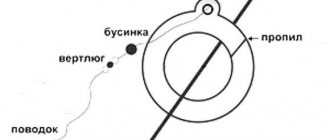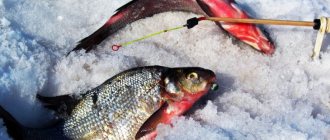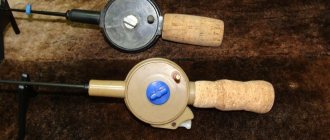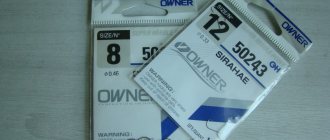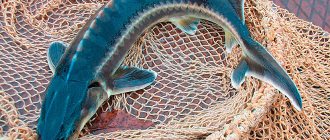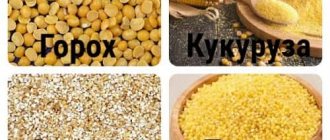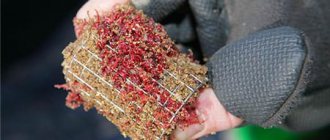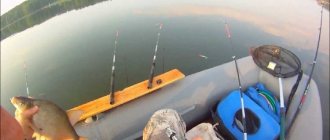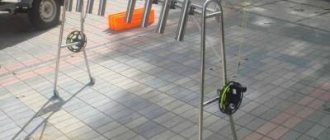Bream lives in almost every body of water and is a rather shy and cautious fish. As a rule, bottom gear is used to catch it; they allow fishing equally fruitfully both from the shore and from a boat, are ideal for long casts, and most importantly, with the help of them you can catch a very large specimen. Such gear is used when it is necessary to fish at depth, in strong winds, rain and other conditions.
The following bottom gear is used to catch bream:
- Rubber bottom - used if the bottom of the reservoir is very muddy or casts are made where there is a lot of vegetation. The only negative is that it is quite problematic to remove the gum from the water.
- A casting donka is ideal for large rivers or lakes; you can easily make long casts.
- Feeder - suitable for any depth, is a more universal tackle, which, due to its flexible top, allows you not to miss a bite. You can catch heavier specimens on the feeder.
The correct set of bottom gear is the key to a rich catch.
The package includes the following steps:
- Assembling the rod and installing the reel. To do this, you need to assemble all the elements, and, most importantly, fix the coil well. Tip: the pass rings must be on the same line.
- Pass the fishing line through the rings and make a knot at one end. Then attach the fishing line to the spool.
- Place a sliding sinker on the fishing line.
- Attach a leash. It is better to use more than one leash.
When bottom fishing for bream, any tackle must meet certain requirements:
- The length should be from 1 to 3 meters, depending on the nature of the reservoir and fishing conditions. It is noted that fishing is also possible with longer options, especially in large bodies of water.
- Medium density.
- Excellent for practicing all the jerks of the bream.
- Be comfortable for the fisherman.
Note: basically, bream weighing from 1 to 3 kilograms are caught on the donk; in rare cases, fish weighing 5 kilograms are caught.
It is better not to use telescopic rods; it is noted that they do not have the sensitivity required for fishing.
An interesting point: the donka for bream has been the most common tackle for decades.
The equipment for the bottom fishing rod should be as follows:
- The reel is a key requirement for free casting and smooth winding of the line;
- Fishing line - the best thickness is from 0.2 to 0.4 millimeters, choose a shade as close as possible to the color of the water in the river or lake. It is better to give preference to a braided cord; it is more durable and can withstand current speed better, plus it is indispensable for long casts. The ideal size is from 0.2 to 0.25 millimeters.
- Hooks – choose the sharpest ones, preferably double or single. If the bait is supposed to be small, then a small hook should be used, and vice versa. It is recommended not to use hooks that are too small; the bream can easily break off.
- Sinker - the choice is made based on the strength of the current, wind and casting distance; the more difficult the conditions, the more weight is needed, and vice versa.
- Feeders (you can do without them) - it’s better to take the open type.
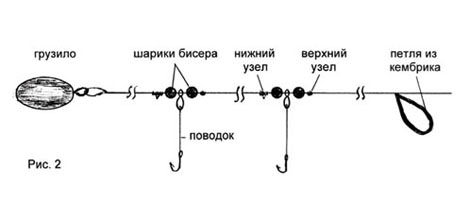
Where to catch bream on a donk?
Bream is one of the most common species of fish, which is found in almost all water areas of our country. Prefers deep holes, with a muddy or clay bottom, less often sandy. Leads a sedentary lifestyle, feeding near its favorite holes and pools. During the day it feeds in the depths, and in the evening it comes out to feed in shallow water.
These habits must be taken into account for successful fishing. It’s not enough just to have good tackle, complementary food and bait, you need to have a good understanding of the behavior and feeding of fish, because without knowing the bream “paths” you can get into trouble, because the most sophisticated bait, and the fattest worm, are not able to lure the bream to an unusual feeding area place.
So how to find this most treasured “bream” place? First of all, you need to find a hole with minimal flow. To do this, you can use an echo sounder, which will accurately show the depth, water temperature, and bottom structure. You can also use indirect signs, such as: the boundary of direct and reverse flow, which most likely means the presence of a hole at the junction of the currents.
You can use one more technique and check the bottom by test casting a weight without hooks and feeders, at an average pace, dragging the weight along the bottom and pulling it out. By wiring you will understand where the boundary of the dump is, what the approximate structure of the bottom is, whether the bottom is rocky, whether there is vegetation there.
This procedure must be repeated several times, moving left and right from the intended fishing spot, so that there is a more complete picture of the bottom. It is also worth considering the coastal vegetation near the hole, the presence of which indicates the possible presence of fish nearby. Abundant bushes in the coastal zone will also be a good sign. Choose a fishing spot depending on the time of day, weather conditions and season.
Bream habitats
The habitat of bream is quite wide, and in our country it is often found in rivers with strong currents and in lakes with standing water. Holes and undercuts, snags, islands of sandy and muddy bottom - this is where you should look for bream. Choosing the right fishing spot is a prerequisite for successful fishing. The main food of bream is:
- mosquito larva;
- snail;
- shell;
- zooplankton;
- insects;
- crustaceans.
In search of food, bream moves over considerable distances, but feeds during daylight hours, preferring to hide in shelter at night. The active bite of this fish begins in early summer, but the first successful fishing with bottom tackle occurs in early spring, even before the start of the spawning period.
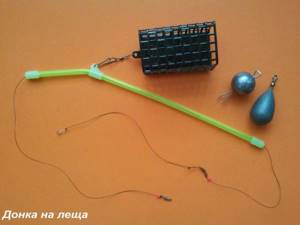
In summer, in hot weather on lakes and other bodies of water with stagnant water, bream does not show activity, and you need to catch it early in the morning, or at sunset. Autumn fishing from the shore gives especially significant catches, because in the autumn months and until early winter, bream feeds very actively, gorging on fat for the whole winter. For catching bream the following are used:
- float tackle;
- feeder tackle;
- Donka.
Bottom tackle for catching bream
The concept of bottom tackle for catching bream includes a combination of several items. First of all, this is a rod designed for casting equipped feeders. Next is the reel, which allows you to cast gear and land fish.
A fishing line or cord that is wound on a reel and serves as a connecting link between the bait and the rod, and the bottom equipment itself is attached to it. Bottom equipment consists of a coiled spring soldered into a lead weight, one or more leashes with hooks for bait. A bite indicator, the role of which can be played by an ordinary twig picked up on the shore, or a special bell.
Recently, electronic indicators based on different principles and having different sensitivity settings have become very popular. Next, let's take a closer look at each item.
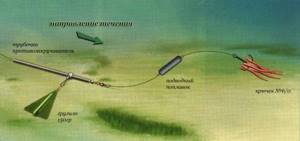
Donka for catching bream at night
A lot of bottoms have been invented for catching bream in the summer at night with illumination of the fishing spot. The use of bottom casting gear for fishing is justified when the fish feeds away from the coastline.
Also, using casting bottoms with correctly selected baits on the hooks of the gear, they catch bream not close to the shore at great depths and not necessarily only at night.
For example, in the hot summer season, bream is forced to spend most of the daytime in deep-water holes with weak currents, going aground during the short-term feeding period at night. Then the donka becomes the most convenient tackle for daytime bream fishing from the bank of a small river.
But the cost of a good bottom rod with feeder equipment for many poor summer fishermen is worth a lot of money, so not the poorest fishermen in Russia catch bream in the summer with a set of feeder rods with bottom equipment.
And fishermen who are “disdainful” of acquiring fat wallets make do with homemade donks with hand-thrown rig sinkers during summer fishing. For them, below in the text is a description of a bottle donkey, convenient for summer bream fishing day and night.
If you open the page using the link, you will see a diagram of the location of the end ends of the donks thrown for catching bream at night at the border of the side dump into the river. Only for night fishing, place the pegs closer to each other. In the morning, this is also a good place for fishing with donks, past which the fish pass to the daytime stops in the hole of the small river.
Rod
The main requirements for a rod for bottom fishing are: length and test. The length determines how far you can throw your bait. The longer the rod, the further your rig will fly. Test - the ability of the form to adequately and effectively work with a particular range of weights. It is best to use specialized “feeder” rods; they are most suitable for bottom fishing.
They have the required length, have sufficient flexibility, and are capable of throwing bottom equipment at a distance of up to 150 meters. The feeder rods come with interchangeable tips of different hardnesses, which are needed to adjust the sensitivity of the tackle. When choosing such a fishing rod, you must first of all be guided by the conditions of the reservoirs where you will be fishing.
For long casts, you need to choose a longer rod. The golden mean is a fishing rod, 3500 cm long and 40 - 80 grams of dough. Telescopic rods are less suitable for bottom fishing. They do not have the necessary flexibility; there is no ability to change sensitivity. The maximum range for them is 40 – 60 meters. But unlike feeder ones, they are several times cheaper.
Modern tackle
In the modern understanding of the fisherman, donka is rather a relic of the past. Increasingly, feeder-type spinning rods and feeder rods are used for bottom fishing. Fishing with a feeder rod without a feeder is called donka by many, but this is not so. The feeder is a much more sporting tackle; there is not such a share of luck in biting fish as in fishing with a donk, and the experience of the fisherman decides much more.
However, there is one type of fishing in which the donka performs better than anything else. This is night fishing for burbot in the fall. It is useless to use bait to catch this fish, since burbot is a predator. And for catching it, luck and the right choice of place are decisive; selection of bait is of secondary importance. What is not a field of activity for a bottom fisherman? A bell at night will be much more effective than a quiver tip on a feeder. And several rods placed will increase the chances of a bite.
You can ask your question to our author:
Reels
The best choice would be an inertia-free, rear-friction reel. A beginner can be advised to take a cheap Chinese reel for the first time, the main thing is that it winds the line evenly, does not interfere with its free flow when casting, and does not throw out beards. But if finances allow, then it is better to immediately spend money on a good one, even if not from branded manufacturers. If, for some reason, you decide to take an inertial drum reel, then you should take a closer look at the “unkillable” salmon.
What to choose: fishing line or braided cord?
How to figure out what to choose: fishing line or cord? You need to understand their fundamental differences. The fishing line is basically a regular nylon thread. The main characteristics of the fishing line are thickness and tensile strength. The thicker the line, the more weight of the fish it can support. The optimal fishing line thickness for bottom fishing is 0.25 – 0.40 mm. Such parameters do not have the best effect on air resistance, which is important in windy weather, and water resistance, which is important in the presence of even a slight current.
Braided cord is more expensive than fishing line, but it is more convenient when used in bottom fishing.
The cord has no memory and does not stretch, which makes hooking much easier. With a smaller thickness, it has greater strength, which significantly reduces the resistance of water and air. The casting distance increases. Braid with a thickness of 0.20 - 0.28 mm is suitable; this is enough to catch the strongest and most lively bream.
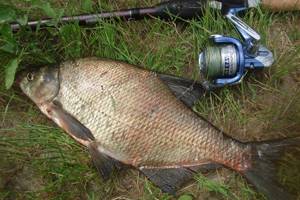
Selection of hooks
We can talk a lot about hooks, but for catching bream, any that meet the following characteristics are suitable. The hook must first of all be sharp, capable of not becoming dull for quite a long time. Constantly check its sharpness on the nail, run the tip along the nail; if the hook picks up the nail, it is sharp enough and slides over it without hindrance, which means it needs to be sharpened with the smallest needle file, or replaced with a new one.
The thickness and size of the hook must be taken into account based on what bait you will use. The smaller the bait, the smaller and thinner the hook for it. But remember, a hook that is too small may bend the fish or fall off it.
Too thick and large, they may scare away wary bream. By varying the size of the hook, you can achieve the optimal value, at which a fish that is too small will not be able to swallow it, and a large fish will not break off. A real fisherman always has several sets of hooks in stock.
Installation of bottom equipment
In the manufacture of bottom tackle, the main role is played by the sinker; it determines the casting distance, fixation of the tackle on the bottom, and the ease of its removal. The heavier the sinker, the farther the tackle will fly, but keep in mind that the weight should not conflict with the test of the rod, the technical data of the reel, and the diameter of the fishing line or braided cord. There are quite a lot of types of equipment. Conventionally, they can be divided into equipment with and without feeders.
To make bottom tackle without using a feeder, you need to take a sinker of the required weight, tie it to the end of a fishing line or braided cord, attach a leash with a hook above the load, it is possible to use several leashes. The leashes must be installed at such a distance that when casting they do not overlap each other.
Options are also possible when one leash is attached below the sinker, and the second above. To prevent twists and overlaps, you can use anti-twisters and rocker arms; you can make them yourself, or you can buy them in a store. The disadvantage of this kind of tackle is that the bait must be thrown separately, and there is no guarantee that it will hit exactly the place you need, it can be carried away by the current, and it will not roll down significantly below the location of the tackle.
The fishing process is greatly facilitated by a tackle with a feeder, which is mounted on a fishing line. A feeder is made from wire, which is wound in the shape of a spring, and the edges are filled with lead. There are many options for making feeders, including the use of plastic bags. The idea of using a feeder is to deliver your complementary food precisely to the fishing spot.
The feeder can be mounted directly on the main fishing line, or secured with a leash. The latter option is less desirable; it complicates the tackle and increases the possibility of twisting. It is more expedient to make sliding feeders, limiting the range of their movement along the fishing line with stoppers in the form of beads, or any other. You can combine the feeder with a sinker by melting a lead weight of the weight you need and pour it into the feeder.
Lately, the hedgehog tackle has been gaining popularity. To make it, you will need: a feeder with a sinker inserted inside or soldered into it, leashes tied to the edges of the feeder, of which there must be at least six pieces. To prevent the leashes from twisting, they can be made from a stiffer fishing line, or heat-shrinkable tubes can be used. Attaching to a fishing line is best done using swivels. If you don’t have the time or desire to make the equipment yourself, you can buy one ready-made in a store.
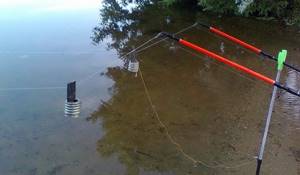
Other types of donks
The above recommendations are suitable for the classic “trick”. However, there are other types of gear. The two most common are:
- feeder;
- "rubber";
- "carousel".
Let's take a closer look at them.
Feeder
The distinctive feature of the donkey feeder for bream is that it uses not an ordinary load, but a metal mesh with bait placed inside. Hence its name - feed translated from English means “feed”.
There are special requirements for the feeder; to assemble the gear, they use special rods with a sensitive tip that signals a bite and spinning reels that allow you to cast the feeder far. However, you can also assemble a feeder from an inexpensive Chinese fishing rod; it is important that it has a flexible tip, which can indicate that the object being fished is interested in the bait.
"Rubber"
“Rubber band” is a type of bottom tackle. Its distinctive feature is the absence of a fishing rod and the presence of a rubber cord between the sinker and the fishing line. This scheme allows you not to pull the entire rig ashore, but to pull part of it with attached hooks towards you, stretching it.
A “spoon” is usually used as a load. Several hooks are tied (at least 3-4), placing the leashes with them perpendicular to the fishing line, that is, they are made retractable.
Fishing with an elastic band is not entirely sporting. Due to the elasticity of the cord, the fish is caught on its own; all that remains is to get it out of the reservoir; this type of gear is used by those who consider fishing as a source of food or income.
Tips for choosing bait for bream
Spring baits
Depending on weather conditions in the spring, bream can actively react to different baits: March: bloodworm, worm, semolina, dough. April worm, maggot, bloodworm. May peas, corn, dough, pasta, semolina, bread, boiled wheat, pearl barley. The higher the air and water temperatures, the faster the bream switches from animal baits to plant baits.
Summer baits
In the summer heat, many complain about a complete lack of bite, but this is not always true. Properly selected bait can attract the attention of bream even in the heat. June: worm, maggot, corn, peas, pasta. July: steamed barley, maggot worms in the form of sandwiches. August: bread, pasta, corn, maggot worm. Temporary decreases in temperature indicators will entail a return of bream to animal types of bait ; vegetable bait should be offered in hot weather.
Autumn lures
In the autumn, bream continue to be actively caught on the feeder; groundbait and bait, as before, should work in tandem in such gear. As the temperature drops, bream will again want “meat” baits. September: earthworm and dung worm, maggot, hominy, bread, steamed cereals. October: bloodworms, worms, less often maggots. November: maggots and bloodworms, plant-based baits will not work. It is important to understand that the bait used in crushed form must be added to the bait .
Winter lures
In winter, bait for bream is very important; it is more difficult for passive fish to attract attention. Therefore, the selection of bait should be approached very carefully. December : sandwiches made from pieces of worms, bloodworms and maggots, less often boiled peas are used. January : bloodworm, worm. February : worm, bloodworm, semolina, peas. You can experiment and try using the dough as bait; at the end of February, bream can respond well to this species.
"Carousel"
It resembles a “rubber band”, differs from it in that it has a heavier load, which is not thrown, but delivered to the right place using a boat. The catch is also taken using it.
In this case, one end of the fishing line is tied to a load, and the other to a stick or tree branch firmly stuck into the bank. There are also several hooks here, as in the case of the “elastic band”, they are attached perpendicular to the fishing line. Due to the longer length and hooks, you can fit much more here.
Victoria Leshchenko
I've been working hard in the fishing tackle department for the past six years. I can help you assemble almost any gear.
Ask a Question
The fishing line on the “carousel” should sag a little - otherwise it will be impossible to get it out of the water.
Lure
The success of any bottom fishing directly depends on the bait you use. With the help of bait, fish are lured and held in the fishing area. You need to select complementary foods based on what kind of fish you will catch. For large fish, you need to use large particles that small fish will not be able to swallow.
In no case should complementary foods saturate the fish; its purpose is to create an aromatic spot on the bottom and surface of the water. If we are talking about manual casting of bait, then you should not make strong bait balls. Upon impact, part of the ball should break on the water, the other part, having reached the bottom, should crumble over it without forming lumps.
When using a feeder, you should also not fill it too tightly. The bait from the feeder must be washed out, otherwise the fish will simply not be fed. Complementary food can be bought at a fishing store; they differ in the types of fish they are designed for and in price, depending on the amount of ingredients contained in it.
You can make your own bait. To do this, you need to decide on the basis. As a base, a cookie scrap sold in stores is suitable. You can use cereals, the most popular are pearl barley and millet.
Breadcrumbs and sunflower cake are suitable for the base. Next, after choosing the main ingredient, you need to select the auxiliary ones. It can be: peas, corn, bloodworms, jigs, cut or whole worms, maggots, coconut flakes, salt, garlic, chocolate, strawberries, sunflower seeds, and much more.
There are several universal recipes
Recipe 1
You need to take a kilogram of scrap cookies, preferably shortbread. Grind the pieces in a blender or mortar until a homogeneous fraction resembling granulated sugar is obtained. Add one hundred grams of white breadcrumbs and mix thoroughly. Grind two hundred grams of sunflower seeds, add to the main mixture, mix. Add fifty grams of dried garlic; you can use garlic-flavored culinary cubes, but then the amount must be halved. Add one hundred grams of rolled oats flakes, crushed into flour. Mix all ingredients thoroughly. The complementary foods are ready.
Recipe 2
Boil a kilogram of millet cereal until slightly undercooked. It is very important that the porridge does not burn, otherwise the burning smell will scare away the fish. Add two hundred grams of canned corn, stir. If possible, add maggot larvae and chopped earthworms. Add maggots to the bait immediately before fishing.
Recipe 3
The basis is sunflower cake, four hundred grams. A glass of corn grits is added. Four hundred grams of ground shortbread cookies. A glass of semolina. Half a kilogram of feed, which can be replaced with any cereals, after finely grinding them into resins.
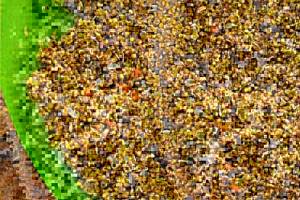
Fishing technique
Choose a promising fishing spot. Prepare your gear and mix some complementary foods. Explore the bottom topography using an echo sounder or other available means. If you use tackle without a feeder, then feed the intended fishing area in advance. To do this, roll five or six balls of bait, aim, try to get them to fall into the water a little closer than the tackle will be.
This is explained by the fact that the bottom topography has the shape of a slide, and the lure is in the shape of a ball and rolls a little lower. Set the bait. Throw the tackle into the water and set the pecking indicator. Remember that under any conditions, you must throw one ball of bait every twenty minutes, regardless of whether you are biting or not. This is necessary to keep fish in the fishing area and attract new schools.
If you use tackle with a feeder, then preliminary feeding is not required. Place the bait in the feeder, adjusting the compression force depending on the speed of the current. The stronger the current, the more you need to compress the bait. You should check the availability of complementary foods every twenty to thirty minutes.
Attach the bait, cast, set the bite indicator. Next, when the indicator is triggered, hook immediately, do not wait for the fish to sit on your hook, this happens extremely rarely. Hook with the rod, with a sharp, strong movement. Start catching fish. Don't pull too fast or too slow. When reeling in quickly, the load on the rod and reel increases, the depreciation of the gear worsens, and with the next blow, the fish may break off.
If it’s slow, the fish can go into the grass, hide behind a snag, dive deeper into the hole, and most likely it will end in death. Always keep a landing net in a visible place; you should be able to reach it without difficulty; most landings occur just under the shore. When the fish is on the shore, put it in the cage or release it. Check the presence of complementary food in the feeders, adjust the bait, and re-throw the tackle.
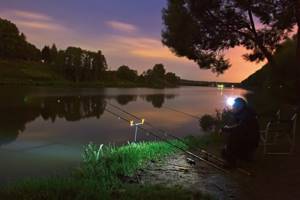
Lure
Making your own bait for bream is not difficult. It must contain peas; they are also used as an attachment. Bream —
I’m a big fan of peas, but you must also use semolina, it ensures the viscosity of the mixture. To prepare homemade bait you will need:
- 1 kg yellow peas;
- 0.5 kg semolina;
- 0.5 kg corn or wheat flour;
- 200g ground sunflower seeds.
Peas for bait should be soft, so you need to prepare it like this:
- 1.5 liters of water is poured into the pan and brought to a boil;
- Pour peas into boiling water and cook until fully cooked;
- little by little add semolina into the softened peas;
- cooking continues for another 10 minutes;
- seeds are added;
- The dough is kneaded with the addition of corn grits.
The finished dough is laid out on a cloth and cools. The cooled dough is wrapped in a damp cloth and placed in the refrigerator. In such conditions it will keep for at least a month and will be fresh.
Important!
You should stir the peas while cooking to prevent them from burning. If the dough becomes dry when kneading, you need to wet your hands with water.
Features of bait at different times of the year
When catching bream using bottom rigs, you need to actively feed the bream only in the warm season, when the water temperature is more than 10-12 degrees. To feed the fishing point, boiled whole peas and corn are used, and this mixture is scattered throughout the swim.
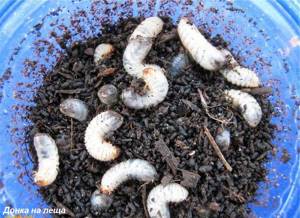
If you are fishing for bream in October using a feeder or other bottom equipment, there is no need for additional feeding; the food supplied in the feeders is sufficient. Fishing for bream in November involves using the most delicate rigs and extra-long leashes.
Important!
Even with active bream biting, it is necessary to regularly supplement the fishing point. For this, bait rockets or boats are used.
Catching bream on a donk at any time of the year and on any body of water —
a very exciting type of fishing. Despite the fact that trophy specimens of this fish are not hooked so often, by choosing the right tactics and catchy gear, you can still achieve decent results.
Features of bream fishing
When catching bream, you should take into account many features of its habits, which depend on the time of year and day. In the spring, before spawning, bream gathers in large schools and begins to actively feed. The fisherman must be very careful, any noise can scare the fish. In the pre-spawning period, the main food for bream is insect larvae that are found in bushes and algae, so there is no need for long casts.
In summer, bream rolls into holes and moves closer to the fairway, so you need to look for it there. It goes out to the shallows and dumps to feed. In autumn, as the weather gets colder, bream completely stops leaving their favorite habitats.
It feeds and starts in strictly defined places. In this case, even very high-quality complementary foods are not able to lure him out. At this time, the fish is especially picky and timid; it ignores moving baits and takes only stationary ones. Therefore, there is no point in fishing in the wiring.
In winter, you should look for bream on the edges; this is where it is caught most successfully. In winter, it avoids maximum depths. Closer to the middle of winter, the fish enters mid-water due to the active rotting of bottom vegetation.
Night fishing for bream, according to many anglers, is much more exciting and can bring a solid trophy. This is explained by the fact that at night, bream leaves their holes in search of food, comes closer to the shore, and becomes less careful than during the day. At night, large individuals approach almost the very shore, therefore, there is no point in making long casts; a distance of five to ten meters is quite suitable.
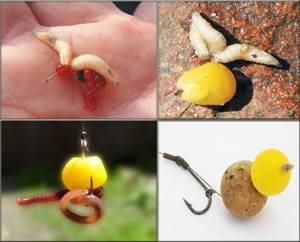
Nuances of choosing bait
Bream is an omnivorous species of fish that can take an interest in virtually any bait of plant or animal origin. Usually it bites well on dough with the addition of a small amount of natural honey, various insects or their larvae.
At the same time, mining preferences depend on many factors, and it may be impossible to predict them in advance, so it is recommended to take into account the following features:
- Grasshoppers and caddisflies are used as bait exclusively in the summer.
- Vegetable baits are good to use during the spring feast or in the summer.
- In autumn it is recommended to use nozzles animal origin, Firstly earthworms, since they are a more nutritious food, and the bream begins to eat off before the onset of cold weather. The same rule applies in early spring as the fish continue to feel hungry after winter.
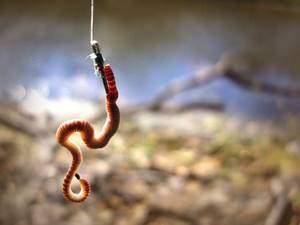
Worm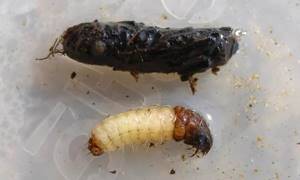
Caddisfly larva
Grasshopper - mounting options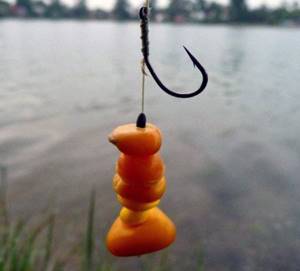
Corn - In most cases, the most effective are “ sandwiches ” that combine plant and animal baits.
- Large bodies of water contain fairly large prey, which often bite well on pasta or earthworms throughout the season.
- It is recommended to have with you a whole set of different baits in order to determine on the spot the most effective option if there is no bite.
General Tips
- If possible, do not skimp on gear; remember, high-quality gear, with good handling and care, will serve you for many years. Cheap and low-quality equipment can let you down at the most inopportune moment, ruining your fishing and your mood.
- Always choose fresh bait.
- Study the bottom topography in detail for any snags. It’s better to spend a couple of minutes preparing than to get into trouble at the most crucial moment.
- Do not use metal cages, as the fish hitting them scares other fish.
- Securely attach bite indicators to your rods. More than one thousand bells flew into the water and were irretrievably lost during a sharp cut.
- Keep quiet, bream is an extremely cautious fish.
- Do not use overly aromatic baits in cold water, this will only scare away the fish.
- Have a couple of working rigs, spare hooks, lines, feeders and sinkers in stock.
- Don’t use a large number of fishing rods at the same time, you’ll be chasing two birds with one stone... you know the rest.
